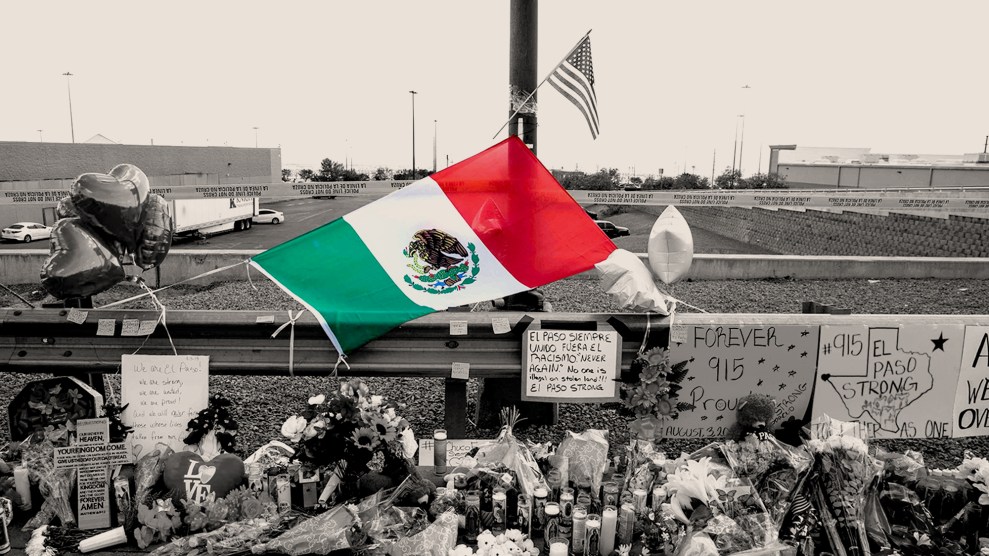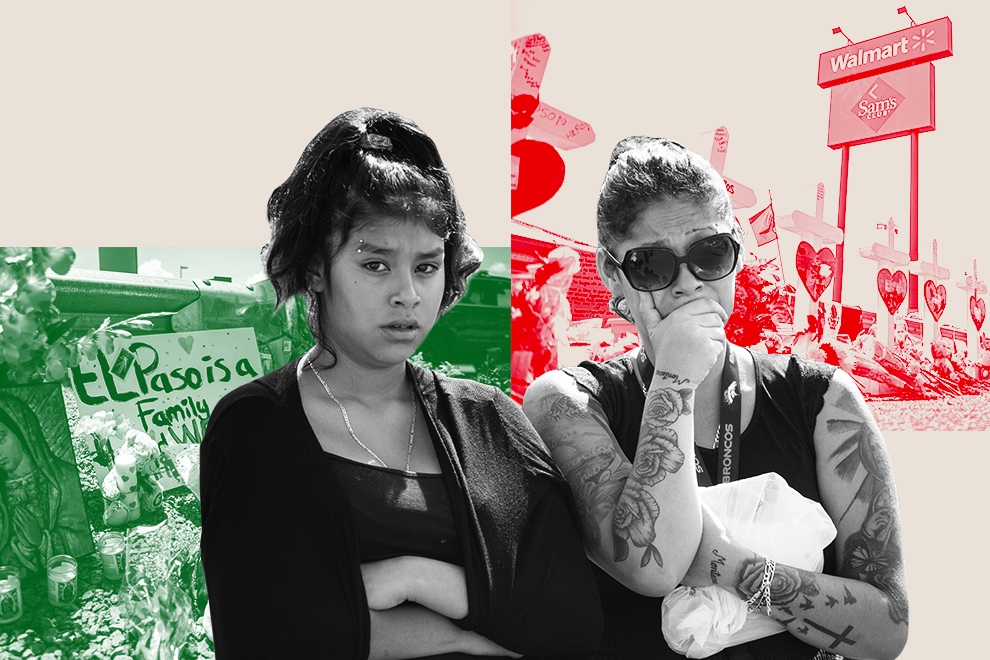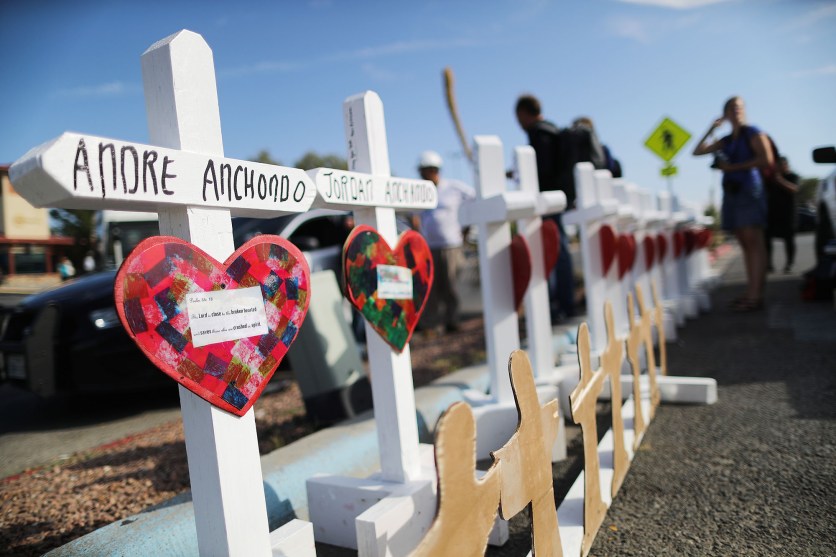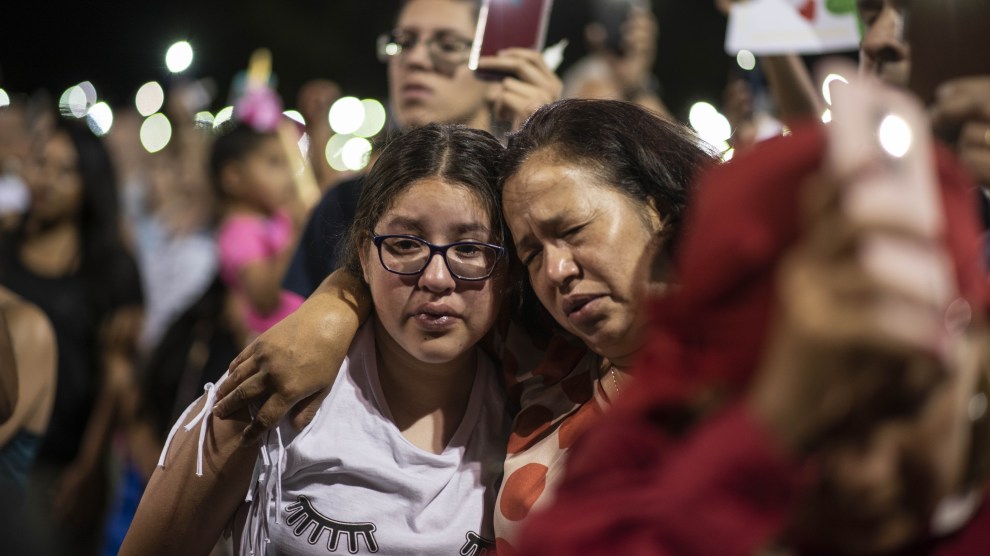
Mother Jones illustration; Lola Gomez/Zuma
Last week, while sweating through my clothes reporting in El Paso in the wake of the deadliest attack on Mexicans and Mexican Americans in recent US history, I got on my phone and noticed a disturbing but familiar conversation happening on Twitter.
The subject was what it’s like to be Latinx in the United States right now, and in threads started by other journalists, people shared daily examples of racist aggressions against them. One such thread, by Adrian Carrasquillo, began, “I truly think the scale of how horrified the Latino community is right now is not being understood”—and the replies turned the conversation into a repository of pain and fear. The stories varied. A young Latina told of walking her dog and getting harassed by a woman, who told her to go back to Mexico and said she’d “beat the shit out of me.” Someone else said they carry their passport card with them at all times, have anxiety in public, and after the shootings at the Pulse nightclub in Orlando and then in El Paso feel “so scared because I look very Hispanic… I can’t stop crying.”
I had to stop reading. It was overwhelming. I had just left the scene of a mass shooting where people were killed for being brown. It was too much to see everything in one thread, from the microaggressions to the flat-out racism, things I’d experienced myself. This was the full picture of being Latinx in the United States in 2019, and at that moment, standing outside of the family resource center that had been set up at a convention center after the shooting, I couldn’t bear to look.
I had flown to El Paso on Monday, two days after the shooting, and when I told my family in Mexico that I was going, they told me, “Te cuidas”—be careful. This wasn’t the first time I covered a mass shooting. I was in Tucson back in 2011, when a young white man killed 6 people and injured 13 outside of a grocery store, including then–US Rep. Gabrielle Giffords. I worked for the local paper at the time, and I knew what it was like to have tragedy hit my hometown. Since then, every time I hear about a mass shooting, I feel the usual run of emotions—anger, sadness, frustration. But this time it felt different. The shooter was targeting the very idea of being Mexican in the United States.
The first thing I did when I got to El Paso was go to the memorial near the Walmart. I spent a few hours watching people come by with flowers, candles, and handwritten signs they placed near the white wooden crosses representing each of the victims who were killed. Some were only there briefly, while others stayed hours in the scorching summer heat. I wasn’t there to report on the details of the incident; I was there to hear directly from the grieving local community.
Virginia Morales held flowers in her hands as she cried and murmured in Spanish, “Why? Why so many innocent people, why so much hate?” The El Paso native was there with her daughter and grandson. She told me that her sister was at Walmart when the shooting happened, but she wasn’t injured. The fact that the shooter had come all the way from Dallas “because he didn’t like Mexicans,” she said, had affected her greatly.
“It feels like an attack to the Hispanic community,” Litzy Chavero told me as she wiped tears from her face. “It’s an attack to our people, not only to Mexican Americans but to the American people.” Chavero, a 19-year-old college student, had grown up between Ciudad Juarez and El Paso, and although she didn’t lose any friends or family members in the shooting, she felt as if she had lost her community. “We were one of the safest cities—why did he need to drive 10 hours just to attack us?”
That’s something I kept hearing over and over: People were frustrated and confused that a man who “wasn’t even from here” would cause so much pain in El Paso. But perhaps it’s because El Paso is the truest representation of everything that this man hated. The city is 81 percent Hispanic, and almost everywhere you go you’ll hear Spanish or Spanglish. (In fact, I’m pretty sure I was only spoken to in English once while I was there, and it was at the airport.) This literally was Mexico until 1845. The whole concept of Mexicans not belonging there or “going back to where they came from” doesn’t really apply here. They’re proudly Mexican, and also they’re as American as anyone else.

At first, I was going to stay at a hotel, but a friend from El Paso said she was at her parents’ house and that I could stay with them. I hadn’t met her family before, but I was still greeted with a hug and a kiss from her mom and grandma when I first got there. They told me that they knew someone close to some of the victims and that they couldn’t believe this had happened in their community. Although I’ve never lived in El Paso, the city felt familiar to me. I spent half my life in Mexico and the other half in Tucson. I went to Nogales and the border often. While I was going to college, I worked retail at a mall where half the license plates in the parking lot were from Sonora. Here in El Paso it was plates from Chihuahua. I could imagine what the mall and the Walmart were like that Saturday morning.
But after the shooting, the people I talked to said El Paso was the quietest they’d seen in a long time. The streets were empty. Some restaurants and bars were closed that night, and people just stayed home. A few said they were afraid to go to the grocery store or go shopping at all, which seems like a common reaction after a mass shooting in your hometown. But this went one step further: There was a sense of compounded vulnerability in being out and about while looking Mexican.
For a while now, El Paso has been the epicenter of the immigration debate in the United States. Democrats pointed to the city and its low crime rates as a way of refuting dark assertions that the border and the people crossing it were unspeakably dangerous. Recently, the city has received thousands of Central American families released by immigration officials after they presented themselves at the border asking for asylum. Photos of overcrowded detention facilities for women and children have come out of El Paso. Lawmakers from across the country have visited the area and held protests and press conferences outside of detention facilities for families and children. The city has become a symbol of the “border crisis” of 2019, and on Saturday it became the site of our worst nightmare coming true.
I’m not going to say the shooter’s name in this post, and I’m not going to reference his alleged manifesto, except to say that it explicitly tied his hatred of immigrants to the current political climate. It’s been hard enough these past two weeks for immigrant communities and for the Latinx population to see those words on TV and to read them in news articles. It’s also really tough for me to copy and paste these words knowing the violent ends to which the shooter put them.
But the thing that is so devastating and enraging is that there was little in this obscene manifesto that doesn’t appear regularly in public discourse. This is how the president of the United States talks, how some columnists write, what millions of people see on TV every night on cable news. My own industry is guilty of this. The country has been talking in obscenities for years now, out in the open.
Having covered immigration and the Latinx community as a reporter, having watched the dials getting cranked higher and higher in recent years, I find myself, in the wake of El Paso, suspended between a sense of shock and a sense of no shock at all. When the person in the highest position of power and authority in the country calls immigrants animals, invaders, gang members, rapists, murderers, it means something. When he only laughs off a comment from his supporters about shooting migrants to stop the invasion at the border, it means something.
We’ve seen this interplay before between rhetoric and violent reality. As Monica Muñoz Martinez told Mother Jones in an interview in late 2018, “In the early 20th century—between 1910 and 1920 especially—there were calls by politicians, by the media, by Anglo residents living near the US–Mexico border, for more policing.” The criminalization of ethnic Mexicans was pervasive, and they were portrayed as a threat to white residents regardless of citizenship. As a result, “vigilantes, Texas Rangers, the state police officers, local law enforcement, and US soldiers denied ethnic Mexicans due process and participated in this reign of terror where people were murdered, tortured, interrogated, and threatened.”
Friends and colleagues have written about all of this since the shooting in El Paso. They point to the fact that while people may say that citizenship and legal status are at the center of the immigration conversation, it really doesn’t matter if we have a blue passport or not. When we speak Spanish and people give us dirty looks, when a stranger says to go back to where we came from, we’re all just brown at that point. Even writing this I feel too exposed. I’m used to telling other people’s stories, trying to get people to open up. Yet here I am, tentative to share what I’ve experienced or how I feel—because as a journalist I’m straddling both worlds, but mostly because the current political environment doesn’t feel safe.
Before I left El Paso on the Tuesday after the shooting, I retreated to the air conditioning of my friend’s childhood home to record an episode of the Mother Jones Podcast. I recapped to my colleagues in New York City what I’d heard from people at the memorial and ended by reading the full names of the 22 victims, most of them Americans of Mexican descent, 8 of them Mexican citizens. One by one, as I recorded their names, each one felt more painful than the last. But it wasn’t until I turned off the recorder and hung up the phone that I broke down. It felt as if I had been holding my breath since the shooting, and now I finally let it out. I know that other Latinx journalists are feeling a version of that. Before joining the Mother Jones team, I worked at NPR’s Latino USA. My colleagues and I would check in with each other after reporting difficult stories, when racist videos went viral, when we heard the derogatory ways in which the administration referred to immigrants. Those check-ins were and still are constant.
Nothing I’m describing here about my own feelings can compare with the pain El Paso residents are feeling. (And it’s important I acknowledge my own privilege in the Latinx community at large. The fears I’m talking about are severely heightened for mixed-status families and the undocumented community, and for those who can’t sometimes “pass.”) As I was leaving the memorial, I saw a woman lift her fist in the air before she yelled, “El Paso strong!” A few people followed her lead, replying, “El Paso strong!” As the people of El Paso have already shown in the days after the shooting, they will come together to grieve and to stand up against racism and violence. They’ll bring out mariachis to play regional Mexican music loud and proud, as they’ve always done. They’ll play the songs that we all know help us grieve. They’ll sing “Amor Eterno.”
Once I got back to Los Angeles, I was at home once again scrolling through social media. First, I saw videos on Twitter recorded just four days after the massacre that showed a group of the president’s supporters at the memorial confronting a mourning community. A tall white man was filmed having a heated argument with what seemed to be mostly older Latinas. The video shows a woman visibly frustrated by the man’s actions, telling him “this happened because we’re brown.” He was defending the president and asked the group to tell him which words the president had said that could be blamed for the massacre. Two women were quick to point out that ever since he was a candidate, he’s called Mexicans rapists and murderers. Later a man who identified himself as a former US Marine began making racist remarks about immigrants and called an older Latino a “fucking idiot” before the crowd asked law enforcement to make the man leave. This happened at a peaceful memorial site where people were grieving.
Not too long after I saw those videos, I came across some others also recorded at the memorial site. These showed pre-Hispanic indigenous dancers and young people singing religious songs. In one video, a young man sang a corrido he wrote describing the shooting. It ended like this: “Lo que este monstruo causó, quiso romper a mi gente, pero eso no lo logró. Ahora estamos más unidos, muchas gracias a Dios.” This monster wanted to break us, he said, but he didn’t succeed and “now, we are more united, thank God.” There was no “debate,” no white man calling into question anyone’s humanity. There were Latinos and Latinas bearing up under their grief. I watched these videos, and then I watched them again, and again.
Listen to the Mother Jones Podcast episode on the El Paso shooting here:
















